1. Successful Cloud Adoption
Overview
Prepare for successful cloud adoption with a well-defined strategy https://learn.microsoft.com/en-us/training/modules/cloud-adoption-framework-strategy/
Narrative
Transform your firm's cloud posture into a highly efficient, well-architected, oiled machine
Strategy

Digital transformation is a substantial bet for many organizations and the technology teams that lead the efforts. A successful digital transformation produces returns for all who are involved. Whether they succeed or fail, digital transformation programs can define careers and the future of a business. Strategic clarity and executive buy-in are imperative for success. A clear commitment to strategic motivations drives investment allocation and helps leaders make difficult technical decisions. Prioritizing motivations is the first step toward creating clarity in corporate strategy. This step helps ensure that all team members are working toward common goals, and it secures executive sponsorship to set budget, modify operations, and review results.
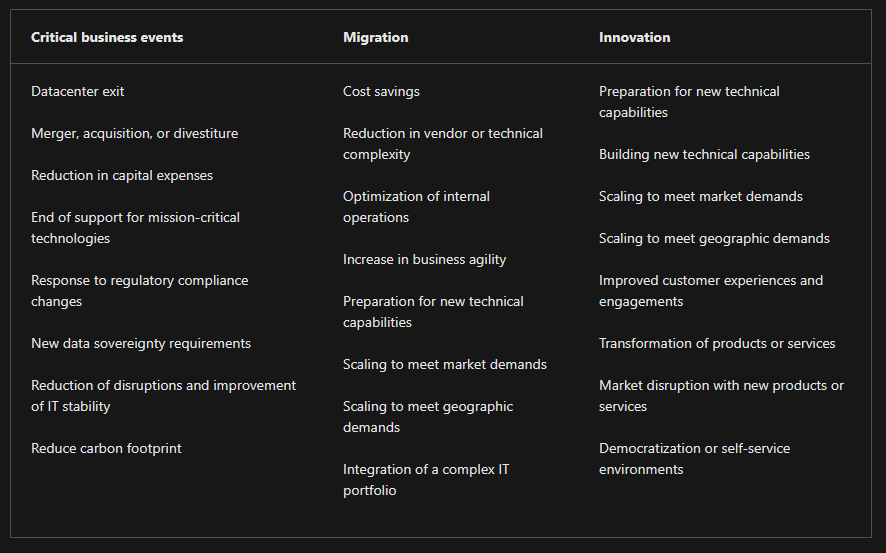
What is the motivation?
- migration?
- responding to critical business events?
- innovation?
Migration:
- Saving on operating costs
- Reducing vendor or technical complexity
- Optimizing internal operations
- Increasing business agility
- Preparing for new technical capabilities
- Scaling to meet market demands
- Scaling to meet geographic demands
Innovation:
- Increasing business agility
- Preparing for new technical capabilities
- Building new technical capabilities
- Scaling to meet market demands
- Scaling to meet geographic demands
- Improving customer experiences and engagements
- Transforming products or services
Stratification
Stratification is a sound principle in macroeconomics. But with the limited budget of most technology-driven change management projects, a stratified approach leads to confusing and distracting signals within the program. More noticeably, multiple, simultaneous investments in competing strategies lead to misalignment of the people, processes, and projects that are required for overall program success. For digital transformations to succeed, organizations must prioritize motivations based on timeline expectations, organizational alignment, and capacity for investment.
To create clarity and alignment, it's suggested that complex digital transformation projects align to an organization's horizons or phased program delivery. In this type of approach, the company commits to a single motivation category for a time-bound period. All teams and organizations prioritize investments and collaborate to support the priority outcome, as needed, for the defined period of time. This approach creates unity, clarity, and drives a snowball effect, allowing the success of one horizon to accelerate the target outcomes of the next horizon.
Cloud Adoption Strategy Evaluator Tool: https://learn.microsoft.com/en-us/assessments/?id=8fefc6d5-97ac-42b3-8e97-d82701e55bab&mode=pre-assessment
- Identifying motivations
- Documenting expected business outcomes
- Evaluating financial considerations
- Technical considerations in creating a business case.
Current State:

Recommendations:
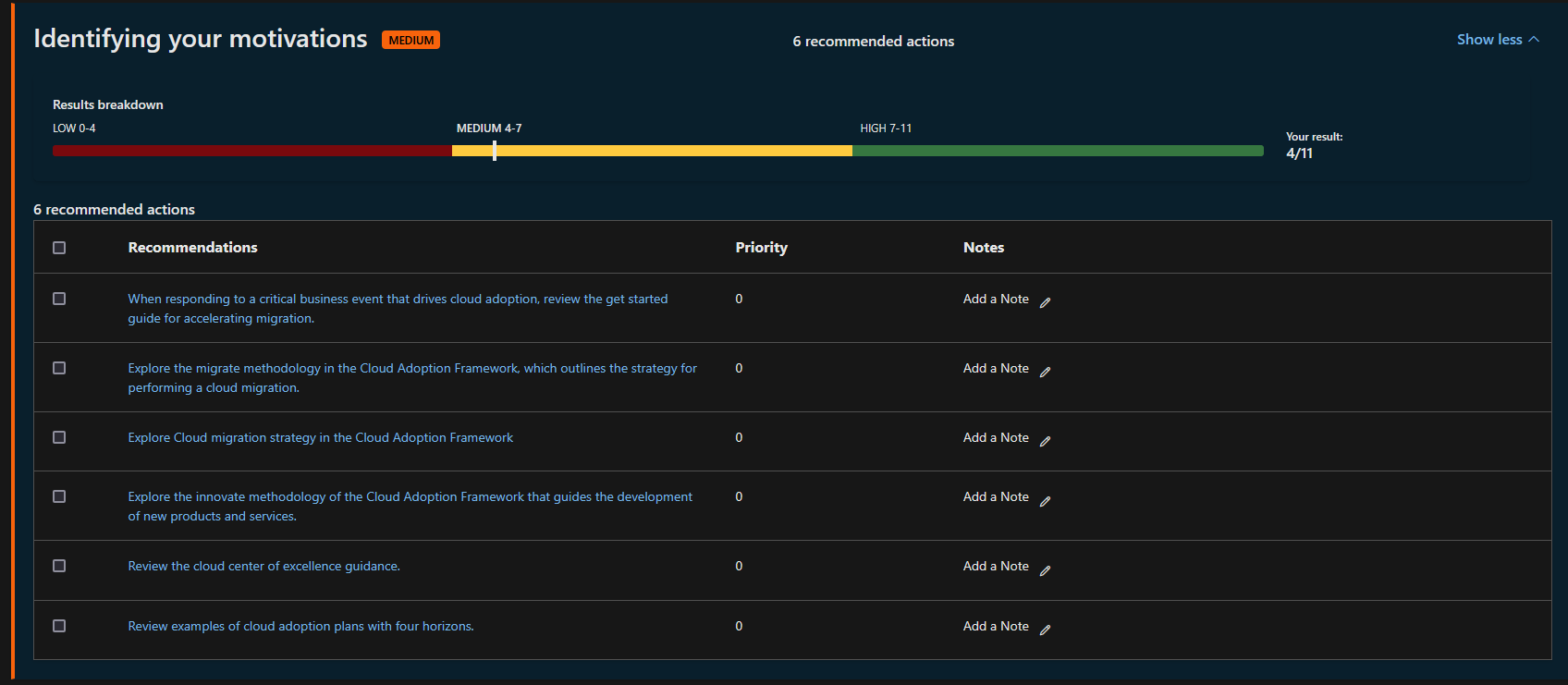
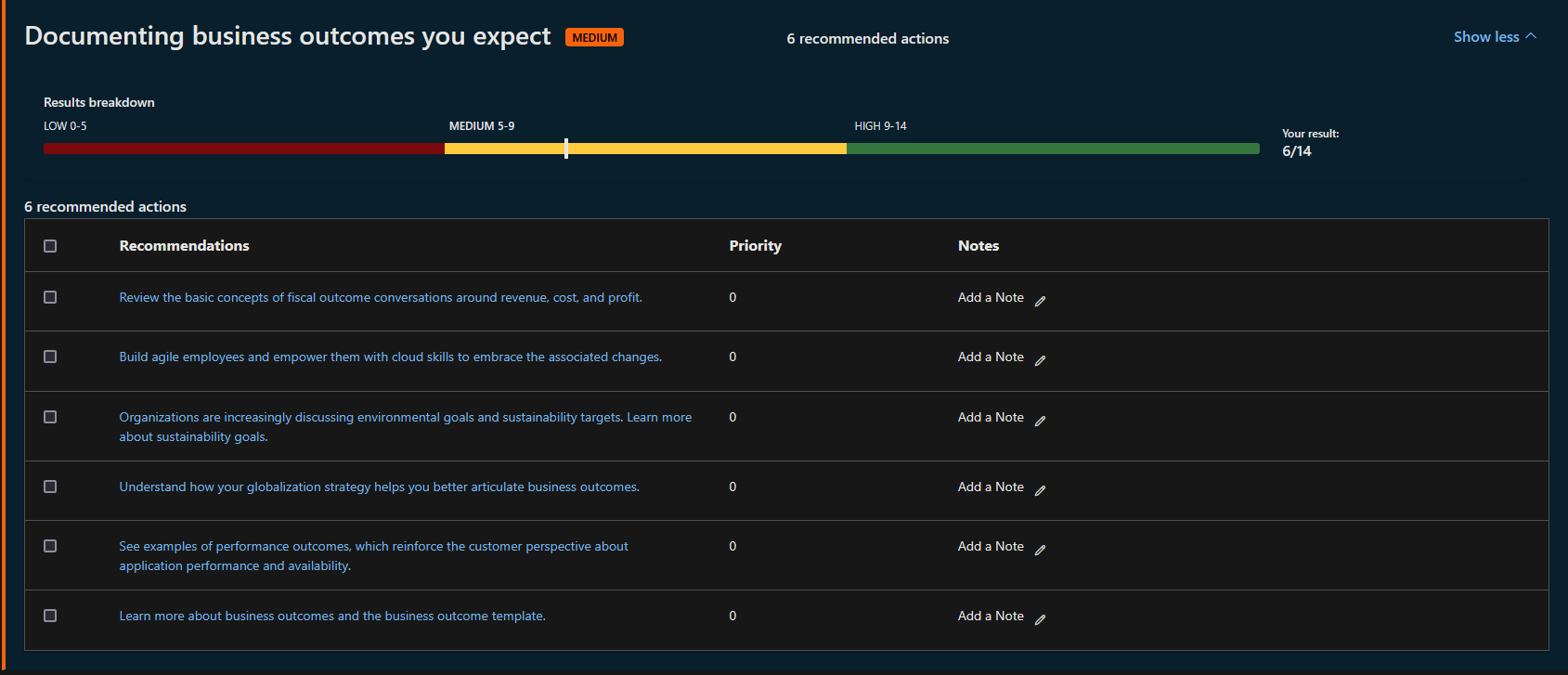

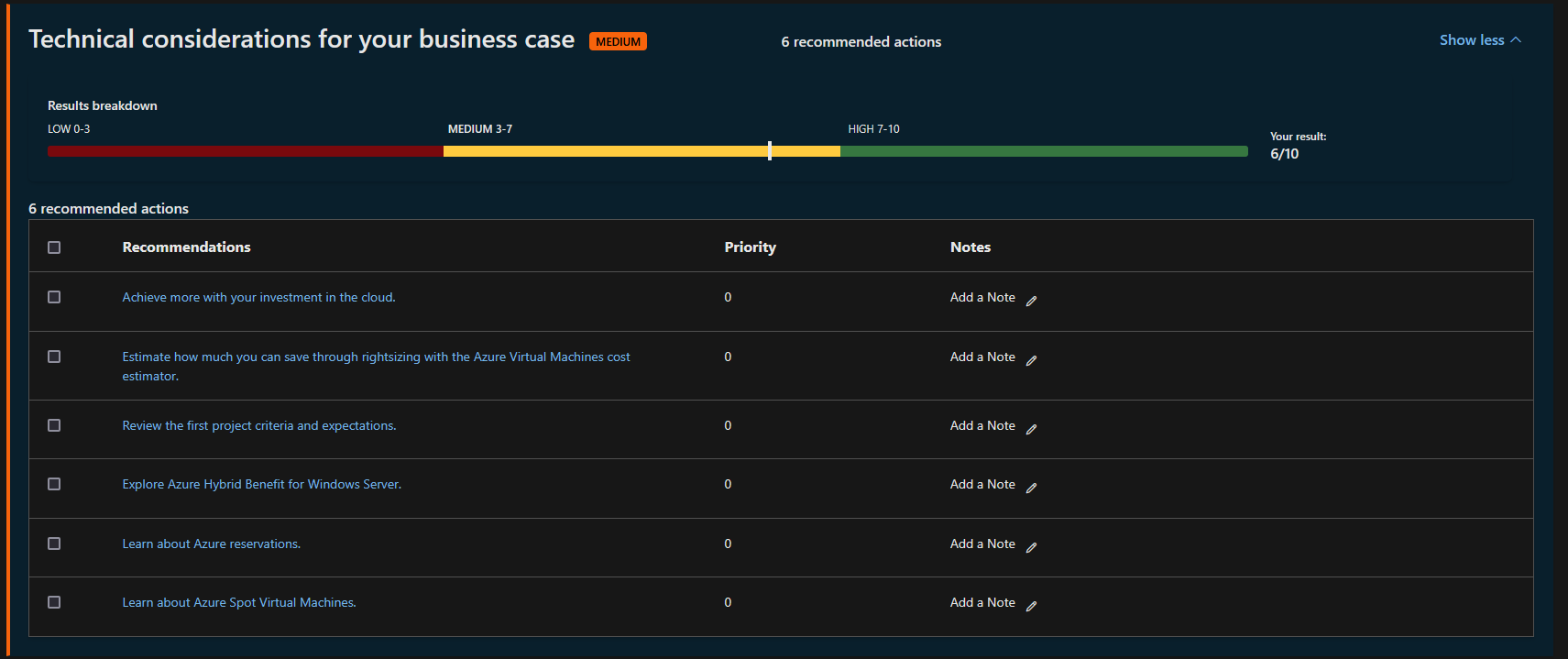


Future State:
OKRs vs KPIs
- Objectives and Key Results
- Key Performance Indicators
Define business outcomes by using OKRs:
Modern operations require modern ways to measure business outcomes, and cloud technology can help increase velocity for a business. An organization's measurement platform should support a company's outcomes and plan for growth by:
- Providing insights to team members and groups.
- Supporting staff to pivot quickly when outcomes don't align with strategy and expectations.
- Offering teams a structured format, templates, sequences, and tools to help them plan for and visualize increasing velocity.
OKR overview
OKRs have proven to drive alignment in complex work environments, foster innovation, and help individuals focus on what matters. Many organizations have begun to use OKRs. OKRs are based on two components: an objective and key results for that objective. An objective is the statement of intent: what is the team trying to accomplish, and why is it important? Key results are specific outcomes that track the impact of the objective: Objective: Clarity and intent Key results: Measures of success within a quarter It's important to understand that OKRs are useful for measuring team outcomes rather than individual performance. Because deadlines often motivate team performance, key results are established quarterly. OKRs help teams focus on the most important tasks instead of on the volume of work at hand. To focus on critical tasks, focus on what happens in a month, a quarter, and other short-term intervals. You can have OKRs that last longer, but shorter intervals emphasize the need for OKRs that track short-term impact.
OKR key principles
Here are the key principles of OKRs:
-
Aspire and inspire: Teams establish their best possible results in a given quarter, focus efforts on great outcomes, and use retrospectives to learn and iterate.
-
Outcome focus: Quarterly key results provide clarity on where value is created. Being aware of where value is created helps teams and the organization drive business impacts faster.
-
Global and local: Teams localize OKRs into their nouns, verbs, and numbers that enrich OKRs with the team's expertise and insights.
-
Transparent: OKRs, alignment, and progress are visible to everyone through OKR software, which simplifies collaboration and supports making good decisions faster.
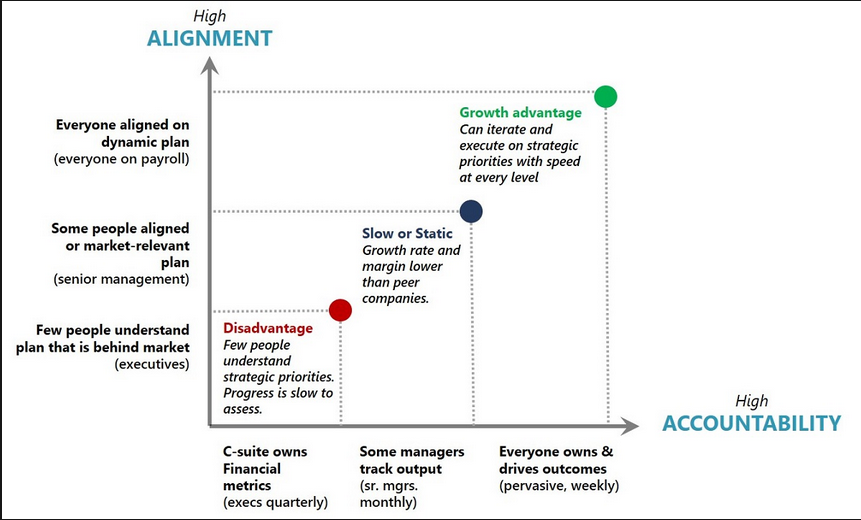
The principles of OKRs can help your organization understand how useful OKRs take form. Objectives need to inspire your company and its teams to fully understand your mission. Key results need to be specific and measurable within a quarter.
Examples: Objective 1: Build a technology platform that supports every person in our business to innovate and create Key results:
- Five new applications developed and adopted across the organization
- Every team with at least two members using Microsoft Power Platform
- Including new cloud technologies like data analytics and machine learning in all customer-facing applications
Objective 2: Transform our approach from sales driven to data driven Key results:
- Increasing pipeline coverage from 50 percent to 200 percent
- Increasing closing rates for sales engagements by 5 percent
- Reducing the time to close deals by 8 percent
Implement OKRs
Step 1: Learn. Start exploring what OKRs can do for your business. Tune in to some of your industry peers and leaders to learn how OKRs have benefited their organizations.
Step 2: Plan. As you begin to draft your OKRs, ensure that your sponsors contribute and are involved in the process. Work with an OKR coach to refine your OKRs.
Step 3: Launch. Each organization launches initiatives differently. Maintain a strong communication plan, and build the OKR calibration and celebration process into your operating model.
Step 4: Drive. To maintain rigor and focus, make sure that you're sharing outcomes and results across the organization. Sharing results and outcomes helps your teams adopt a habit of using OKRs.
Step 5: Improve. Continue to improve, revisit, and rethink how you connect across the organization. OKRs in spreadsheets can be useful, but an organization can benefit most from everyone participating to meet objectives and gain insights from the aligned data.
Financial Considerations
Terms
Balance sheet: In the cloud you can shift datacenter operations costs into modernization, developing cloud applications, and other projects that drive business growth. This shift can make your balance sheet more agile.
Cash flow statement: The pay-for-what-you-consume model and the ability to apply policies and tags to your Azure resources can help you improve the predictability of your cash flow statement. This model improves the timing of your cash flow by delaying spend.
Income statement (profit and loss): You can improve profitability over time by taking advantage of Azure's flexibility, low management costs, services, and pricing models.
Amortization: An expense tied to a typically intangible asset that reflects the economic usage of that asset in a particular time period. For example, if you purchase a license worth USD100, you'd capitalize that on your balance sheet. If you amortized it over five years, you'd annually recognize an expense of USD20 per year that impacts your income statement.
Balance sheet: A balance sheet is a financial statement that reports a company's assets, liabilities, and shareholders' equity as of a specific date.
Capital Expense (CAPEX): The upfront investment in equipment. This equipment is capitalized as an asset and put on your balance sheet.
Cash flow statement: A cash flow statement is a financial statement that summarizes the amount of cash and cash equivalents entering and leaving a company during a given period. Cloud economics: An understanding of the benefits and costs of the cloud, and the financial impact when you start a migration from on-premises to cloud computing.
Depreciation: An expense tied to a capitalized asset that reflects the economic usage of that asset in a particular time period. For example, if you purchase a server worth USD100, you'd capitalize that on your balance sheet. If you depreciated it over five years, you'd annually recognize an expense of USD20 per year that impacts your income statement.
Double-mortgage period: A period when you have two sets of costs at the same time. For example, when you have both on-premises and cloud costs.
Earnings before interest, taxes, depreciation, and amortization (EBITDA): A performance indicator of the profitability of a business. This metric starts from operating income, which is the income from your ongoing business operations (ignoring things like taxes or interest expense) and adds back depreciation and amortization. While a useful performance metric that's used for comparability, it's often viewed along with metrics like Capital Expenditure to have a better all-up understanding of a company's ability to generate free cash flow.
Net Present Value (NPV): An assessment of the financial value of a business investment. This metric looks at cash flows, timing, and the required interest rate.
Operating Expense (OPEX): The ongoing expenses for a business. For example, a maintenance payment or periodic bill for Azure services.
Profit and Loss (P&L): A financial statement that summarizes the revenues, costs, and expenses incurred over a specified period, usually a fiscal quarter or year. It's also referred to as the income statement.
Return on Investment (ROI): Return on investment (ROI) is a metric used to understand the profitability of an investment. ROI compares how much you paid for an investment to how much you earned to evaluate its efficiency.
Outcomes
- Fiscal
- Agility
- Reach
- Customer Engagement
- Performance
- Sustainability
- AI considerations
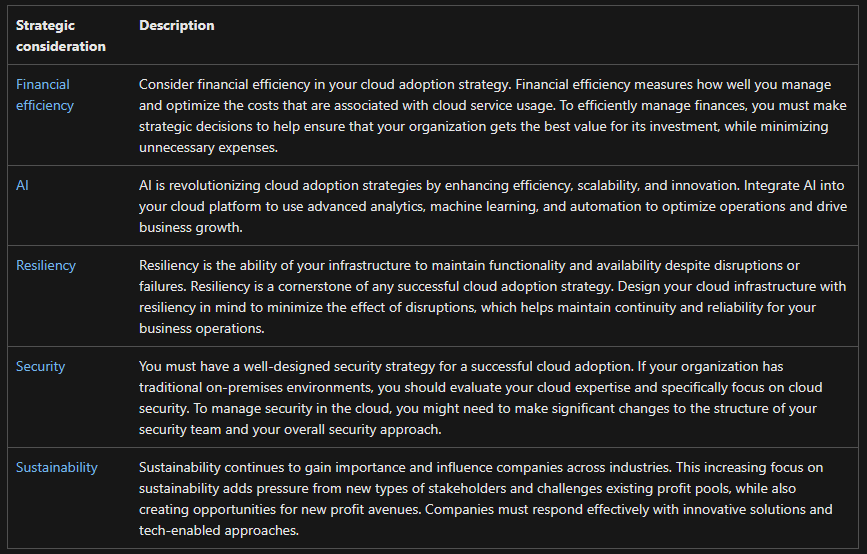
Shift to OpEx model:
- inform
- implement budgets
- maximize return on investment
To implement financial efficiency in cloud adoption, you must effectively manage and optimize cloud investments to ensure that they deliver maximum business value. During this process, you must:
- Gain a clear understanding of cloud usage and associated costs.
- Quantify the business value of cloud initiatives.
- Optimize spending strategically to align with organizational goals and avoid unnecessary expenditures.
FinOps Framework: https://learn.microsoft.com/en-us/cloud-computing/finops/
Consider return on investment and revenue and cost changes (deltas)
Cloud Accounting
Models:
- Cost center - IT as the cost center - This perception of IT is limited and might be shortsighted.
- Profit Center - IT is competing business unit and can make $.
- Showback - a safer first step in the transition from cost center to value center. Shift in awareness and mindset.
- Chargeback - The operating-expenses model of cloud cost accounting required
Technical Considerations
- Pay as you go model
- Understanding workloads
- Idle capacity
- Unpredictable workloads
- Predictable workloads
- initial cleanup and rightsizing
Goal is to get from Grey to Dark Blue across ALL architectures
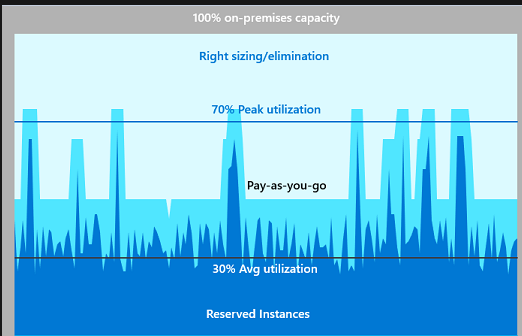
Cost saving offers
Hybrid benefit
- Spot iinstances
- Reservations/Savings Plans
- Dev/Test pricing
- Azure Advisor
- Azure Advisor cost recommendations
- Learn the Microsoft Azure Well-Architected Review
- Learn the Microsoft Azure Well-Architected Framework
First Migration
The goal of your cloud business case is to achieve more with every dollar invested. You can accomplish this goal by releasing committed cash flows and budgets that can be reinvested into further modernization. This concept is the velocity of the dollar; you accelerate value per dollar through phased reinvestment driving modernization and value.
- Lift and shift
- IaaS
- PaaS
Beginning a first adoption process in parallel with developing the plan provides the following benefits:
- Establishes a growth mindset to encourage learning and exploration
- Provides an opportunity for the team to develop necessary skills
- Creates situations that encourage new approaches to collaboration
- Identifies skill gaps and potential partnership needs
- Provides tangible inputs to the plan
Your team's first adoption project is likely to result in a production deployment of some kind, but it isn't always the case. Establish proper expectations early. Here are a few wise expectations to set for the first project:
- The project is a source of learning.
- The project might result in production deployments, but it's likely to require more effort first.
- The output of the project is a set of clear requirements to provide a longer-term production solutio
Other examples:
- BCDR: Beyond Site Recovery, you can implement multiple BCDR strategies as a first project.
- Nonproduction: Deploy a nonproduction instance of a workload.
- Archive: Cold storage can place a strain on datacenter resources. Moving that data to the cloud is a solid quick win.
- End of support (EOS): Migrating assets that have reached EOS is another quick win that builds technical skills. It also might provide some cost avoidance from expensive support contracts or licensing costs.
- Virtual desktop interface: Creating virtual desktops for remote employees can provide a quick win. In some cases, this first adoption project might also reduce dependence on expensive private networks in favor of commodity public internet connectivity.
- Dev/test: Remove dev/test from on-premises environments to give developers control, agility, and self-service capacity.
- Basic applications (fewer than five): Modernize and migrate a basic application to quickly gain developer and operations experience.
- Performance labs: When you need high-scale performance in a lab setting, use the cloud to quickly and cost-effectively provision those labs for a short time.
- Data platform: Create a data lake that has scalable compute for analytics, reporting, or machine learning workloads, and migrate to managed databases by using dump/restore methods or data migration services.
Alignment:
- Start to understand support needs
- Consider partnership options that fit your culture and needs
- Evaluate a shortlist of partner options
- Begin contract and paperwork reviews with selected partners
Support:
- Strategy: Support defining the business strategy, building a business case, and supporting technology strategy
- Plan: Support with discovery of the portfolio, quantitative assessment of the digital estate, development of a cloud adoption plan, and the creation of a skilling plan
- Ready: Support deploying a landing zone or full cloud environment capable of supporting the cloud adoption plan
- Migrate: Assistance migrating workloads or building a migration factory to ensure sound migration processes
- Innovate: Assistance developing new solutions or rebuilding/rearchitecting existing solutions to drive innovation
- Govern: Support or ongoing managed services to provide governance and controls across the cloud environment
- Manage: Support or ongoing managed services to operate the cloud platform and the workloads hosted in the cloud
Tools:
- FastTrack for Azure
- Azure Migration Program
- Solution Assessments
Business Cases
Key components of a business case:
When you're planning your business case to migrate to the cloud, there are several key components to consider. Environment scope, technical and financial: As you build out the on-premises view of your environment, think about how your environment scope, from both a technical and financial perspective, is aligned. You want to be sure the technical environment you're using for your plan matches up to the financial data. Baseline financial data: Cost to run today: When you build out your business case, it’s important to pull your baseline financial data. Common questions you can ask to gather the financial data needed are:
- How much does it cost to run my environment today?
- What am I spending on servers in an average year?
- What am I spending in my data center operations categories, for example, power or lease costs?
- When is the next hardware refresh?
Projections for the application or for your entire tech stack can be investigated.
Yes, your operating costs are going to drop and you're going to gain value by running in Azure.
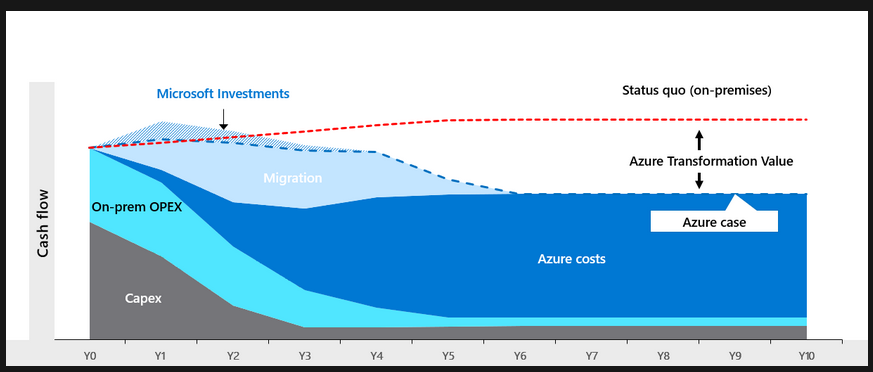
Look at Total Cost of Ownership (TCO) - the Calculator - https://azure.microsoft.com/pricing/tco/calculator
Retail Rates Prices API
- Solution Assessment
- Azure Pricing Calculator
- Azure Migration Program
Summary
- Create clarity on corporate strategy to ensure that all team members are working toward common goals
- Establish metrics to create clarity, help the team learn, and systematically work toward your organizational objectives
- Evaluate financial considerations to understand the value of cloud adoption
- Evaluate technical considerations to help the team prepare for successful cloud-adoption projects